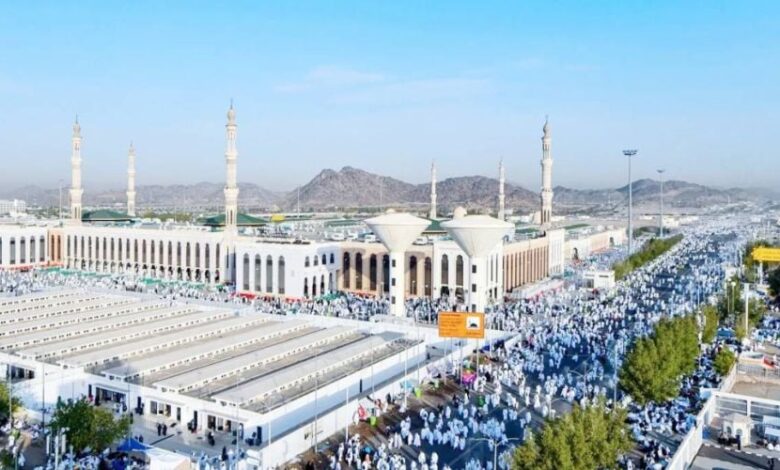Millions of pilgrims journey to Mount Arafat for the Hajj 2025 preaching.

The annual Hajj pilgrimage has commenced, with roughly two million pilgrims residing in the enormous tent city of Mina.
Hajj, one of the five pillars of Islam, attracts millions of Muslims globally each year, representing a once-in-a-lifetime spiritual pilgrimage for those who can afford it.
The atmosphere in Makkah resonates with the fervent cries of Labbaik Allahumma Labbaik as pilgrims initiate the hallowed pilgrimage.
A total of 88,301 Pakistani pilgrims are participating under the government system, while an additional 27,012 are undertaking Hajj through private operators. Pilgrims from Pakistan have been conveyed to Mina by busses from residential locales such as Aziziyah, Naseem, and Batha Quraish.
Upon donning the ihram and performing two rakats of prayer, the pilgrims expressed their intention for Hajj and proceeded to Mina. On the morning of the 9th of Dhul-Hijjah, they would advance to the plains of Arafat for the paramount ritual of Hajj – Wuquf-e-Arafat (Standing at Arafat).
Subsequent to the Hajj discourse on the 9th of Dhul-Hijjah, pilgrims will perform the combined Zuhr and Asr prayers and remain in Arafat until sunset.
They will go to Muzdalifah without conducting the Maghrib prayer in Arafat, where they will combine the Maghrib and Isha prayers and spend the night outdoors.
During their time in Muzdalifah, pilgrims will gather pebbles for the ritual stoning of the demon. On the morning of the 10th of Dhul-Hijjah, they will undertake Ramy al-Jamarat (the stoning of the great devil) by casting seven pebbles. Sacrificial ceremonies will ensue, and male pilgrims will shave their heads (halq), while female pilgrims will trim their hair, signaling the conclusion of Ihram.
On the 11th of Dhul-Hijjah, pilgrims will cast seven pebbles at each of the three devils — the little, medium, and enormous. Subsequent to the Ramy, they will proceed to the Holy Kaaba for the Tawaf al-Ziyarah (Farewell Tawaf), followed by the Sa’i ceremony between Safa and Marwah.
The stoning ceremony persists on the 12th of Dhul-Hijjah, following midday. Pilgrims may choose to return to their accommodations in Makkah on the 12th or extend their stay in Mina to complete the ritual on the 13th Dhul-Hijjah.
Chanting “Labbaik Allahumma Labbaik” (“Here I am, O God, here I am answering Your call”), more than 1.5 million pilgrims from around the world gathered in Mina on Wednesday, marking the official beginning of Hajj with the Day of Tarwiyah.
Pilgrims began arriving in the early hours of the day, with the Saudi authorities executing a flawless operational plan to ensure smooth and secure transportation. By Wednesday afternoon, the influx of pilgrims into the huge tent city of Mina had successfully concluded. Over 8,000 buses transported worshippers from Makkah to Mina in an atmosphere filled with spirituality and devotion.
This year, more than 1.47 million international pilgrims are participating in the annual pilgrimage, joined by hundreds of thousands of domestic pilgrims. Among them are 2,443 pilgrims from 100 countries, hosted as guests of the Custodian of the Two Holy Mosques, King Salman.
Upon arrival in Makkah on Tuesday, pilgrims performed Tawaf Al-Qudum (the Tawaf of Arrival), one of the essential rites of Hajj, before heading to Mina. The valley reverberated with the pilgrims’ recitation of the Talbiyah, creating an atmosphere of unity and deep religious commitment.
Retracing the noble tradition of the Prophet Muhammad (peace be upon him), pilgrims will spend the night in Mina in prayer and reflection, preparing for the pivotal rite of Wuquf (Standing) at Arafat on Thursday—considered the most significant pillar of Hajj.
Saudi authorities, in collaboration with Hajj missions from around the world, have mobilized more than 40 government agencies and deployed 250,000 personnel to manage the pilgrimage. Artificial intelligence and drone technology are being used extensively to monitor crowds and streamline services.
Grand Mufti Sheikh Abdulaziz Al-Sheikh, head of the Council of Senior Scholars, received visitors at his Mina residence on Wednesday and appointed five scholars to issue religious guidance during Hajj. Sheikh Abdulrahman Al-Sudais, head of Religious Affairs at the Grand Mosque and the Prophet’s Mosque, urged pilgrims to continue reciting the Talbiyah until they begin the stoning ritual at Jamarat Al-Aqaba on the 10th of Dhul Hijjah.
Pilgrims have also been urged to pray on time and follow the prescribed format of shortening but not combining prayers, with the exception of Maghrib and Fajr, which should be performed in full.
With temperatures soaring, the Ministry of Health has issued heat advisories, emphasizing hydration, sun protection, and reduced physical exertion during peak sunlight hours (10 a.m. to 4 p.m.). Pilgrims have been seen using white umbrellas to protect themselves from the intense sun, as Saudi Arabia implements enhanced heat-mitigation measures following last year’s dangerous heat wave.
Hajj, one of the five pillars of Islam, spans five to six days and remains one of the largest annual religious gatherings in the world.